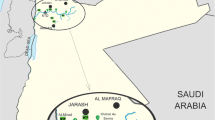Abstract
Fish were selected as a common target sample for a collaborative study of FNCA(Forum for Nuclear Cooperation in Asia)-NAA(neutron activation analysis) project in 2011. Six Asian countries took part in this work. Fish samples were purchased from commercial markets and prepared by following an agreed protocol. Toxic and essential elements in the prepared samples were determined by NAA. The concentration levels of As, Hg in many fish samples have higher values than the regulation ones. The fish contamination by heavy metals should be monitored continuously for human health.


Similar content being viewed by others
References
FNCA-Forum for Nuclear Cooperation in Asia. http://www.fnca.mext.go.jp/english/rru/naa/e-naa_intro. Accessed 6 Oct 2014
Food and Agricuture Organization(FAO) FAO Fisheries and Aquaculture Department (2012) The state of world fisheries and aquaculture. The United Nations, Rome
Tuzen M (2009) Food Chem Toxicol 47:1758–1790. doi:10.1016/j.fct.2009.04.029
Kwaansa-Ansah EE, Akoto J, Admado AA, Nam D (2012) Int J Environ Prot 2(7):30–34
Low KH, Zain SM, Abas MR (2011) Food Anal Methods 4:276–285. doi:10.1007/s12161-010-9166-0
Moon JH, Ebihara M, Ni BF, Arporn B, Setyo P, Theresia RM, Wee BS, Abd Salim NA, Pabroa PCB (2012) J Radioanal Nucl Chem 291:217–221. doi:10.1007/s10967-011-1245-1
de Corte F (1987) The k 0-standardization method—a move to the optimization of neutron activation analysis. Rijksuniversiteit Gent, Belgium
Ministry of Health Malaysia (1995) Malaysian food act 1983 and food regulations 1985, Kuala Lumpur
World Health Organization (2006) Trace elements in human nutrition and health. WHO, Geneva
Fisheries and Aquaculture Department, Food and Agriculture Organization of the United Nations. http://www.fao.org/fishery/statistics/global-consumption. Accessed 07 Oct 2014
Korea Center for Disease Control and Prevention (2010) The Fourth Korean National Health and Nutrition Examination Survey (KNHANES IV)
JECFA Reports, Food Safety, World Health Organization. http://www.who.int/foodsafety/publications/jecfa-reports/en. Accessed 7 Oct 2014
Acknowledgments
This research has been carried out by the support of the Ministry of Education, Culture, Science and Technology of Japan. In case of Korea, this work was supported by the National Research Foundation of Korea(NRF) grant funded by the Korea government(MSIP) (No. 2012M2A2A6004263).
Author information
Authors and Affiliations
Corresponding author
Rights and permissions
About this article
Cite this article
Moon, J.H., Ni, B.F., Theresia, R.M. et al. Analysis of consumed fish species by neutron activation analysis in six Asian countries. J Radioanal Nucl Chem 303, 1447–1452 (2015). https://doi.org/10.1007/s10967-014-3732-7
Received:
Published:
Issue Date:
DOI: https://doi.org/10.1007/s10967-014-3732-7




